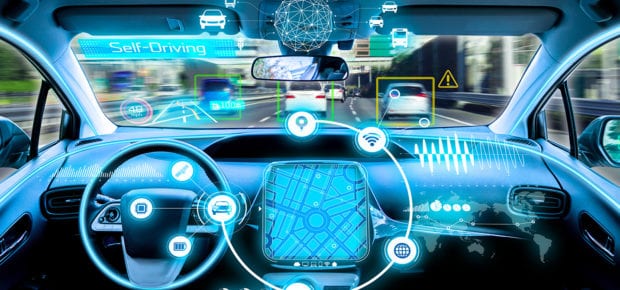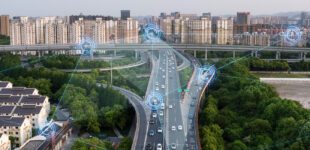May 25, 2018
With self-driving cars slated to hit European roadways in 2021, the question of how they’ll communicate with other vehicles is an increasingly pressing one. What’s emerging is the Internet of Vehicles, a system that will allow vehicle-to-vehicle communications, as well as greater insight into human-driven connected cars and trucks on the road. We talked with some of our expert members to find out more about the technologies involved, and the impact they’re likely to have.
Computing Power
The number of computers and sensors already in use in cars we own is likely to surprise you – according to Kevin Curran, IEEE Senior member and a professor of cybersecurity at Ulster University, “Vehicles have evolved to contain a complex network of as many as 100 independent computers, or electronic control units (ECUs).” These ECUs rely on over 20 million lines of code, particularly in today’s luxury cars. When outfitted for full self-driving capability, that number will increase.
Communications
Having vehicles communicate with each other and with their surroundings is crucial for safety. Fortunately, automakers and governments have been working on this for a number of years. Two interactions are at the core of their work:
- Road-to-vehicle communications. Curran: “We can expect driverless cars to become more reliant on indestructible road sensors embedded in the road and ‘turned on’ during construction, maintenance or in emergencies, alerting each vehicle to the need to reduce speed or halt.” These communicative infrastructures will also include traffic signal control systems, parking information, weather reports, and more.
- Vehicle-to-vehicle communications. Curran, again: “With 5G technology offering less than 10ms latency, we can have proper real-time communication with cars, which can be the difference between life and death.” In the event of an accident, this technology “could automatically send vital details to emergency services such as time of collision, GPS location, vehicle description, vehicle licence number and registered owner,” saving crucial moments in life-threatening situations.
Benefits
In welcome news, the Internet of Vehicles will help alleviate (although not entirely eradicate) traffic, reducing the 250 hours the average commuter spends behind the wheel a year. It will also cut down on collisions, potentially up to 80 percent by 2035, because, as Curran says, “self-driving cars don’t get distracted as much.”
Robust sensors also have great implications when it comes to deliveries. Sukanya Mandal, IEEE member (India): “It’s always been challenging to keep track of the vehicle that is out for logistical delivery. In my opinion, the Internet of Vehicles plays a significant role in the safe delivery of goods as it enables real-time tracking of shipments, warehouse-capacity optimization, predictive asset maintenance, route optimization, and improved last-mile delivery.”
When to Expect It
Society is rarely quick to embrace automotive change. Even life-saving technologies like antilock brakes took years to catch on.
For Shawn Chandler, IEEE Senior member and director at Navigant, “The Internet of Vehicles is truly in its infancy today, but given recent advances, will likely transport the majority of goods between distribution centers safely within the next five years.” Due to the complexity of delivery in traffic and close quarters, adoption in urban environments will take longer.
IEEE’s Involvement
IEEE has two societies with a heavy focus on the intelligent automotive field: the Vehicular Technology Society (VTS) and the Intelligent Transportation Systems Society (ITSS). Make sure to read about the VTS’ work with the IEEE 1609 Family of Standards for Wireless Access in Vehicular Environments, which is helping secure vehicle-to-vehicle communications.
To see how the Internet of Vehicles is changing our food supply chain, visit our hot topic on agriculture and the Internet of Things.






 Meaningful Momentum or Running in Place?
Meaningful Momentum or Running in Place? AI Through Our Ages
AI Through Our Ages Liquid Infrastructure: Our Planet's Most Precious Resource
Liquid Infrastructure: Our Planet's Most Precious Resource The Impact of Technology in 2025
The Impact of Technology in 2025 Quantum and AI: Safeguards or Threats to Cybersecurity?
Quantum and AI: Safeguards or Threats to Cybersecurity? Why AI Can't Live Without Us
Why AI Can't Live Without Us Bits, Bytes, Buildings and Bridges: Digital-Driven Infrastructure
Bits, Bytes, Buildings and Bridges: Digital-Driven Infrastructure Impact of Technology in 2024
Impact of Technology in 2024 Emerging AI Cybersecurity Challenges and Solutions
Emerging AI Cybersecurity Challenges and Solutions The Skies are Unlimited
The Skies are Unlimited Smart Cities 2030: How Tech is Reshaping Urbanscapes
Smart Cities 2030: How Tech is Reshaping Urbanscapes Impact of Technology 2023
Impact of Technology 2023 Cybersecurity for Life-Changing Innovations
Cybersecurity for Life-Changing Innovations Smarter Wearables Healthier Life
Smarter Wearables Healthier Life Infrastructure In Motion
Infrastructure In Motion The Impact of Tech in 2022 and Beyond
The Impact of Tech in 2022 and Beyond Cybersecurity, Technology and Protecting Our World
Cybersecurity, Technology and Protecting Our World How Technology Helps us Understand Our Health and Wellness
How Technology Helps us Understand Our Health and Wellness The Resilience of Humanity
The Resilience of Humanity Harnessing and Sustaining our Natural Resources
Harnessing and Sustaining our Natural Resources Creating Healthy Spaces Through Technology
Creating Healthy Spaces Through Technology Exceptional Infrastructure Challenges, Technology and Humanity
Exceptional Infrastructure Challenges, Technology and Humanity The Global Impact of IEEE's 802 Standards
The Global Impact of IEEE's 802 Standards Scenes of our Cyber Lives: The Security Threats and Technology Solutions Protecting Us
Scenes of our Cyber Lives: The Security Threats and Technology Solutions Protecting Us How Millennial Parents are Embracing Health and Wellness Technologies for Their Generation Alpha Kids
How Millennial Parents are Embracing Health and Wellness Technologies for Their Generation Alpha Kids Space Exploration, Technology and Our Lives
Space Exploration, Technology and Our Lives Global Innovation and the Environment
Global Innovation and the Environment How Technology, Privacy and Security are Changing Each Other (And Us)
How Technology, Privacy and Security are Changing Each Other (And Us) Find us in booth 31506, LVCC South Hall 3 and experience the Technology Moon Walk
Find us in booth 31506, LVCC South Hall 3 and experience the Technology Moon Walk Virtual and Mixed Reality
Virtual and Mixed Reality How Robots are Improving our Health
How Robots are Improving our Health IEEE Experts and the Robots They are Teaching
IEEE Experts and the Robots They are Teaching See how millennial parents around the world see AI impacting the lives of their tech-infused offspring
See how millennial parents around the world see AI impacting the lives of their tech-infused offspring Take the journey from farm to table and learn how IoT will help us reach the rising demand for food production
Take the journey from farm to table and learn how IoT will help us reach the rising demand for food production Watch technical experts discuss the latest cyber threats
Watch technical experts discuss the latest cyber threats Explore how researchers, teachers, explorers, healthcare and medical professionals use immersive technologies
Explore how researchers, teachers, explorers, healthcare and medical professionals use immersive technologies Follow the timeline to see how Generation AI will be impacted by technology
Follow the timeline to see how Generation AI will be impacted by technology Learn how your IoT data can be used by experiencing a day in a connected life
Learn how your IoT data can be used by experiencing a day in a connected life Listen to technical experts discuss the biggest security threats today
Listen to technical experts discuss the biggest security threats today See how tech has influenced and evolved with the Games
See how tech has influenced and evolved with the Games Enter our virtual home to explore the IoT (Internet of Things) technologies
Enter our virtual home to explore the IoT (Internet of Things) technologies Explore an interactive map showcasing exciting innovations in robotics
Explore an interactive map showcasing exciting innovations in robotics Interactively explore A.I. in recent Hollywood movies
Interactively explore A.I. in recent Hollywood movies Get immersed in technologies that will improve patients' lives
Get immersed in technologies that will improve patients' lives